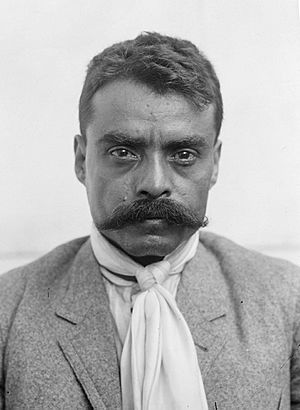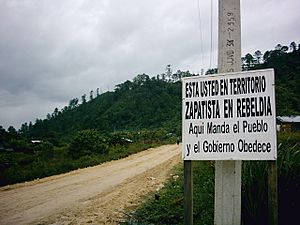Emiliano Zapata facts for kids
Quick facts for kids
Emiliano Zapata
|
|
|---|---|

Zapata in 1914
|
|
| Nickname(s) | El Caudillo del Sur, Attila of the South, and "E" |
| Born | August 8, 1879 Anenecuilco, Morelos, Mexico |
| Died | 10 April 1919 (aged 39) Chicameca, Morelos, Mexico |
| Allegiance | Mexico (Zapatismo revolutionary forces) |
| Years of service | 1910–1919 |
| Rank | General |
| Commands held | Liberation Army of the South |
| Battles/wars | Mexican Revolution |
| Signature |  |
Emiliano Zapata Salazar ( August 8, 1879 – April 10, 1919) was a Mexican revolutionary. He was a leading figure in the Mexican Revolution of 1910–1920, the main leader of the people's revolution in the Mexican state of Morelos, and the inspiration of the agrarian movement called Zapatismo.
Contents
Early life
Zapata was born in the rural village of Anenecuilco in Morelos, to Gabriel Zapata and Cleofas Jertrudiz Salazar of Anenecuilco, Morelos, the ninth of ten children. Contrary to popular legend, the Zapatas were a well-known local family and reasonably well-off.
Gabriel Zapata was a farmer and horse trainer, and Emiliano's upbringing on the farm gave him an intimate familiarity with the difficulties of the countryside and his village's long struggle to regain the land taken by expanding haciendas. He received a limited education from his teacher, Emilio Vara, but it included "the rudiments of bookkeeping". Gabriel died when Emiliano was about 16 or 17, leaving the latter to care for his family. Emiliano was entrepreneurial and bought a team of mules to haul maize from farms to town and bricks to the Hacienda of Chinameca; he was also a successful farmer, growing watermelons as a cash crop. He was a skilled horseman and competed in rodeos and races, as well as bullfighting from horseback. These skills as a horseman brought him work as a horse trainer for Porfirio Díaz's son-in-law, Ignacio de la Torre y Mier who had a large sugar hacienda nearby.
Career
At that time peasant communities were repressed by the small-landowning class who monopolized land and water resources for sugarcane production with the support of dictator Porfirio Díaz (President from 1877 to 1880 and 1884 to 1911). Community members in Anenecuilco, including Zapata, sought redress against land seizures.
In 1892, a delegation had an audience with Díaz, who with the intervention of a lawyer, agreed to hear them. Although promising them to deal favorably with their petition, Díaz had them arrested and Zapata was conscripted into the Federal Army. Under Díaz, conscription into the Federal Army was much feared by ordinary Mexican men and their families. Zapata was one of many rebel leaders who were conscripted at some point.
Mexican Revolution
When the Revolution broke out in 1910 Zapata became a leader of the peasant revolt in Morelos. He, along with other peasant leaders, formed the Liberation Army of the South, and soon became its undisputed leader. Zapata's forces contributed to the fall of Díaz, defeating the Federal Army in the Battle of Cuautla in May 1911. However, when the revolutionary leader Francisco I. Madero became president he called the Zapatistas 'mere bandits' and did not recognize their role in the Revolution.
In November 1911 Zapata called for substantial land reforms (Plan de Ayala). He wanted to redistribute lands to the peasants. Madero sent the Federal Army to root out the Zapatistas in Morelos. Madero's generals employed a scorched-earth policy they burnt villages and forcibly removed their inhabitants, drafted many men into the Army or sent them to forced-labor camps in southern Mexico. Such actions strengthened the peasants' support of Zapata, and he succeeded in driving the forces of Madero, led by Victoriano Huerta, out of Morelos. In a coup against Madero in February 1913, Huerta took power in Mexico, but a coalition of Constitutionalist forces in northern Mexico, led by Venustiano Carranza, Álvaro Obregón and Francisco "Pancho" Villa, ousted him in July 1914 with the support of Zapata's troops. Zapata did not recognize the authority that Carranza asserted as leader of the revolutionary movement, continuing his adherence to the Plan de Ayala.
After the victory over Huerta, the revolutionaries attempted to sort out power relations in the Convention of Aguascalientes (October to November 1914). Zapata and Villa broke with Carranza, and Mexico descended into a civil war among the winners. Zapata focused his energies on rebuilding society in Morelos (which he now controlled), instituting the land reforms of the Plan de Ayala. Carranza consolidated his power and defeated Villa in 1915. Zapata initiated guerrilla warfare against the Carrancistas. They in turn invaded Morelos, employing once again scorched-earth tactics to oust the Zapatista rebels. Zapata re-took Morelos in 1917 and held most of the state against Carranza's troops until he was killed in an ambush in April 1919. After his death, Zapatista generals aligned with Obregón against Carranza and helped drive Carranza from power. In 1920 Zapatistas obtained important positions in the government of Morelos after Carranza's fall, instituting many of the land reforms suggested by Zapata.
Appearance
Emiliano had a striking appearance, with a large mustache in which he took pride, and good quality clothing described by his loyal secretary: "General Zapata's dress until his death was a charro outfit: tight-fitting black cashmere pants with silver buttons, a broad charro hat, a fine linen shirt or jacket, a scarf around his neck, boots of a single piece, Amozoqueña-style spurs, and a pistol at his belt." In an undated studio photo, Zapata is dressed in a standard business suit and tie, projecting an image of a man of means.
Personal life
As far as is known, Zapata fathered a total of 16 documented children with 9 women.
Legacy

Zapata's influence continues to this day, particularly in revolutionary tendencies in southern Mexico. In the long run, he has done more for his ideals in death than he did in life. He came to be viewed as a martyr to the cause of land reform after his murder. Even though Mexico still has not implemented the sort of land reform he wanted, he is remembered as a visionary who fought for his countrymen.
Zapata is now one of the most revered national heroes of Mexico. To many Mexicans, especially the peasant and indigenous citizens, Zapata was a practical revolutionary who sought the implementation of liberties and agrarian rights outlined in the Plan of Ayala. He was a realist with the goal of achieving political and economic emancipation of the peasants in southern Mexico and leading them out of severe poverty.
Many popular organizations take their name from Zapata. Towns, streets, and housing developments called "Emiliano Zapata" are common across the country and he has, at times, been depicted on Mexican banknotes.
The tomb of Zapata is located in Cuautla, Morelos, and every year several festivities are held around the anniversary of his death.
Images for kids
-
Emiliano Zapata, posing in Cuernavaca in 1911, with a rifle and sword, and a ceremonial sash across his chest. (Archivo General de la Nación, Mexico City. Archivo Fotográfico Díaz, Delgado y García).
-
Francisco I. Madero, Zapata, in Cuernavaca. Zapata rebelled against Madero in 1911, because of Madero's slowness to implement land reform.
-
Pancho Villa (left), "Commander of the División del Norte (Division of the North)", and Emiliano Zapata, "Commander of the Ejército Libertador del Sur (Liberation Army of the South)". Villa is sitting in the presidential chair in the Palacio Nacional.
-
Francisco Villa (left), Eulalio Gutiérrez (center), and Emiliano Zapata (right) at the Mexican National Palace (1914)
-
Equestrian statue of Emiliano Zapata, dedicated by President José López Portillo in Cuernavaca, Morelos, 1978, showing General Zapata with a machete rather than a military sword
-
Emiliano Zapata enters Cuernavaca in April 1911. Federal General Manuel Asúnsolo turns the city over to the Zapatistas
See also
 In Spanish: Emiliano Zapata para niños
In Spanish: Emiliano Zapata para niños




















